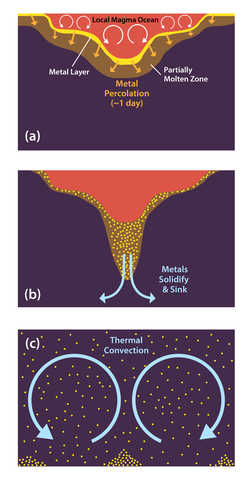New research proposes impact-driven mixing of mantle materials for current mantle composition, shedding light on Earth's precious metals

A new study has found a geophysically plausible scenario to explain the abundance of certain precious metals, including gold and platinum, in the Earth’s mantle.
Scientists hypothesize that early in Earth’s evolution, about 4.5 billion years ago, the Earth sustained an impact with a Mars-sized planet and the Moon formed from the debris that was ejected into an Earth-orbiting disk.
The study's simulations used the mixing of mantle materials to explain how the metals could have been prevented from completely sinking into the Earth’s core, and that mantle convection could be responsible for redistributing the materials and retaining HSEs in the mantle.
Dr. Simone Marchi from Southwest Research Institute collaborated on a recent study that found the first geophysically plausible scenario explaining the abundance of precious metals in the Earth's mantle, including gold and platinum. The simulations carried out by scientists suggest that an impact-driven mixing of mantle materials could prevent the metals from completely sinking into the Earth's core.
The Earth sustained an impact with a Mars-sized planet about 4.5 billion years ago, resulting in the formation of the Moon from the debris ejected into an Earth-orbiting disk. The so-called "late accretion" followed, during which planetesimals as large as our Moon impacted the Earth, delivering materials like highly "siderophile" elements (HSEs) - metals with a strong affinity for iron - that were integrated into the young Earth.
Previous simulations of impacts penetrating Earth's mantle showed that only small fractions of a metallic core of planetesimals are available to be assimilated by Earth's mantle, while most of these metals, including HSEs, quickly drain down to the Earth's core. This brings us to the question: how did Earth get some of its precious metals? To explain the metal and rock mix of materials in the present-day mantle, the researchers developed new simulations.
The relative abundance of HSEs in the mantle points to delivery via impact after Earth's core had formed; however, retaining those elements in the mantle proved difficult to model - until now. The new simulation considered how a partially molten zone under a localized impact-generated magma ocean could have stalled the descent of planetesimal metals into Earth's core.
The researchers modeled mixing an impacting planetesimal with mantle materials in three flowing phases - solid silicate minerals, molten silicate magma, and liquid metal. The rapid dynamics of such a three-phase system, combined with the long-term mixing provided by convection in the mantle, allows HSEs from planetesimals to be retained in the mantle.
In this scenario, an impactor would crash into the Earth, creating a localized liquid magma ocean where heavy metals sink to the bottom. When metals reach the partially molten region beneath, the metal would quickly percolate through the melt and, after that, slowly sink toward the bottom of the mantle. During this process, the molten mantle solidifies, trapping the metal. That's when convection takes over, as heat from the Earth's core causes a very slow creeping motion of materials in the solid mantle, and the ensuing currents carry heat from the interior to the planet's surface.
"Mantle convection refers to the process of rising hot mantle material and sinking colder material," lead author Dr. Jun Korenaga from Yale University said. "The mantle is almost entirely solid although, over long geologic time spans, it behaves as a ductile and highly viscous fluid, mixing and redistributing mantle materials, including HSEs accumulated from large collisions that took place billions of years ago."

 How to resolve AdBlock issue?
How to resolve AdBlock issue?